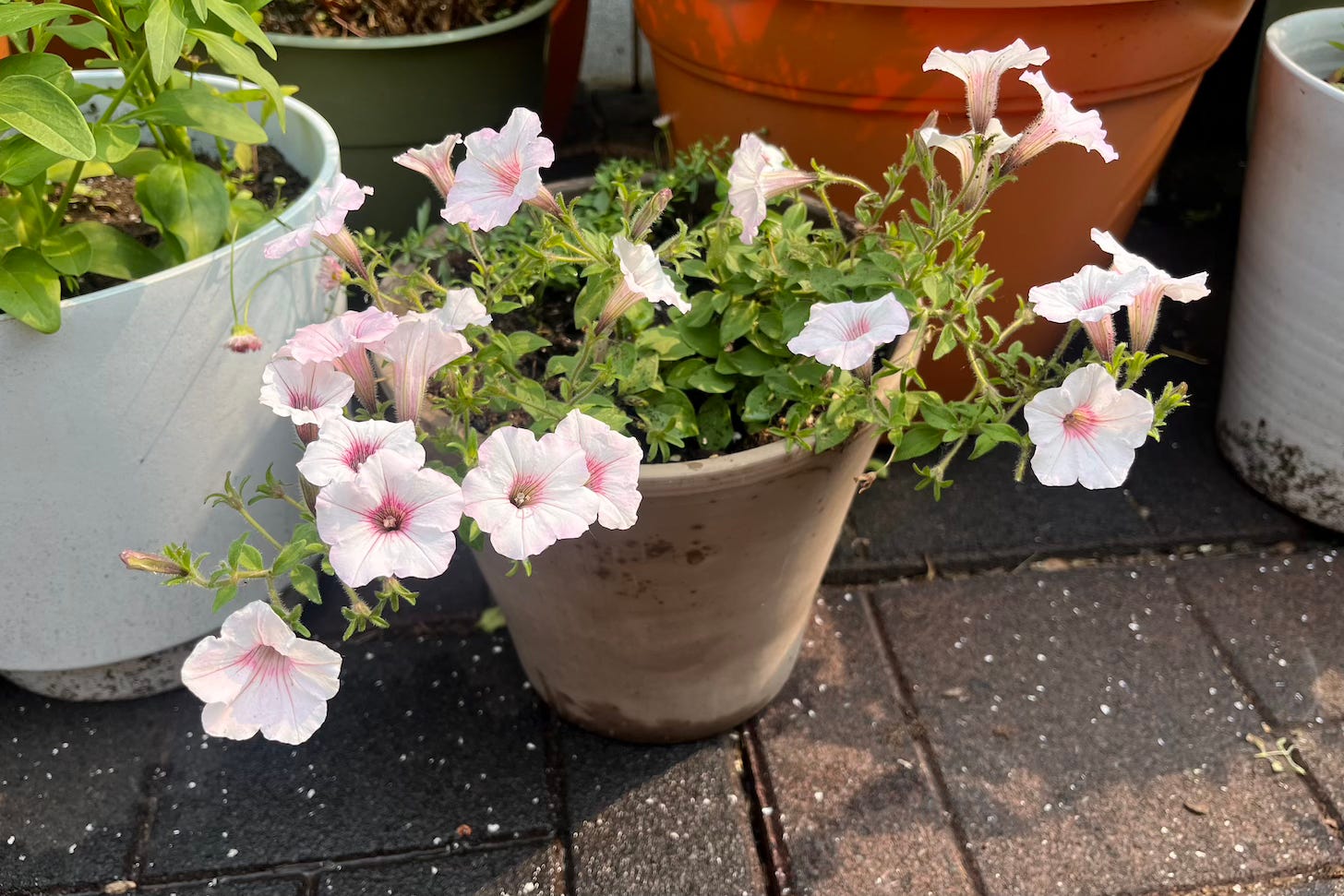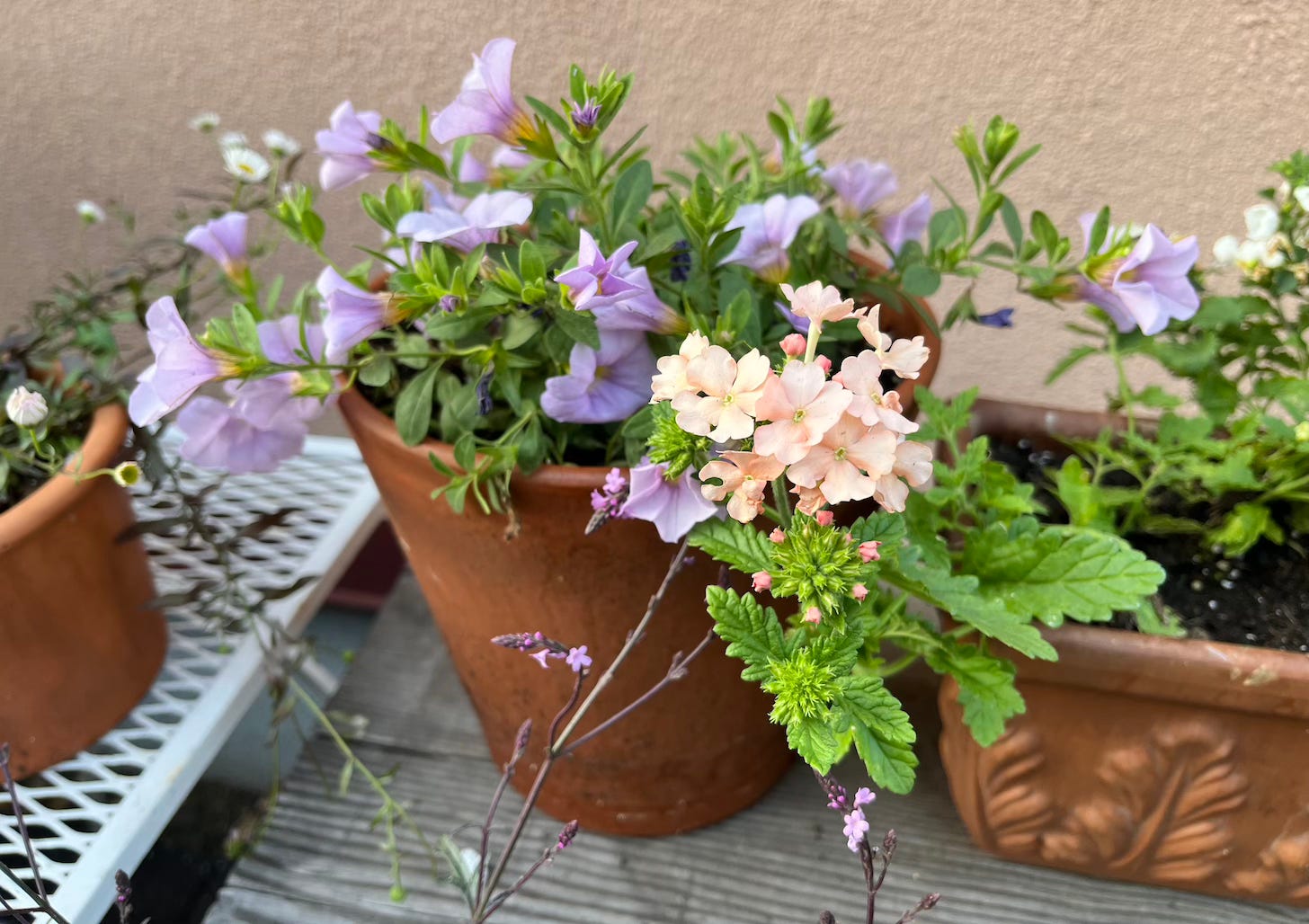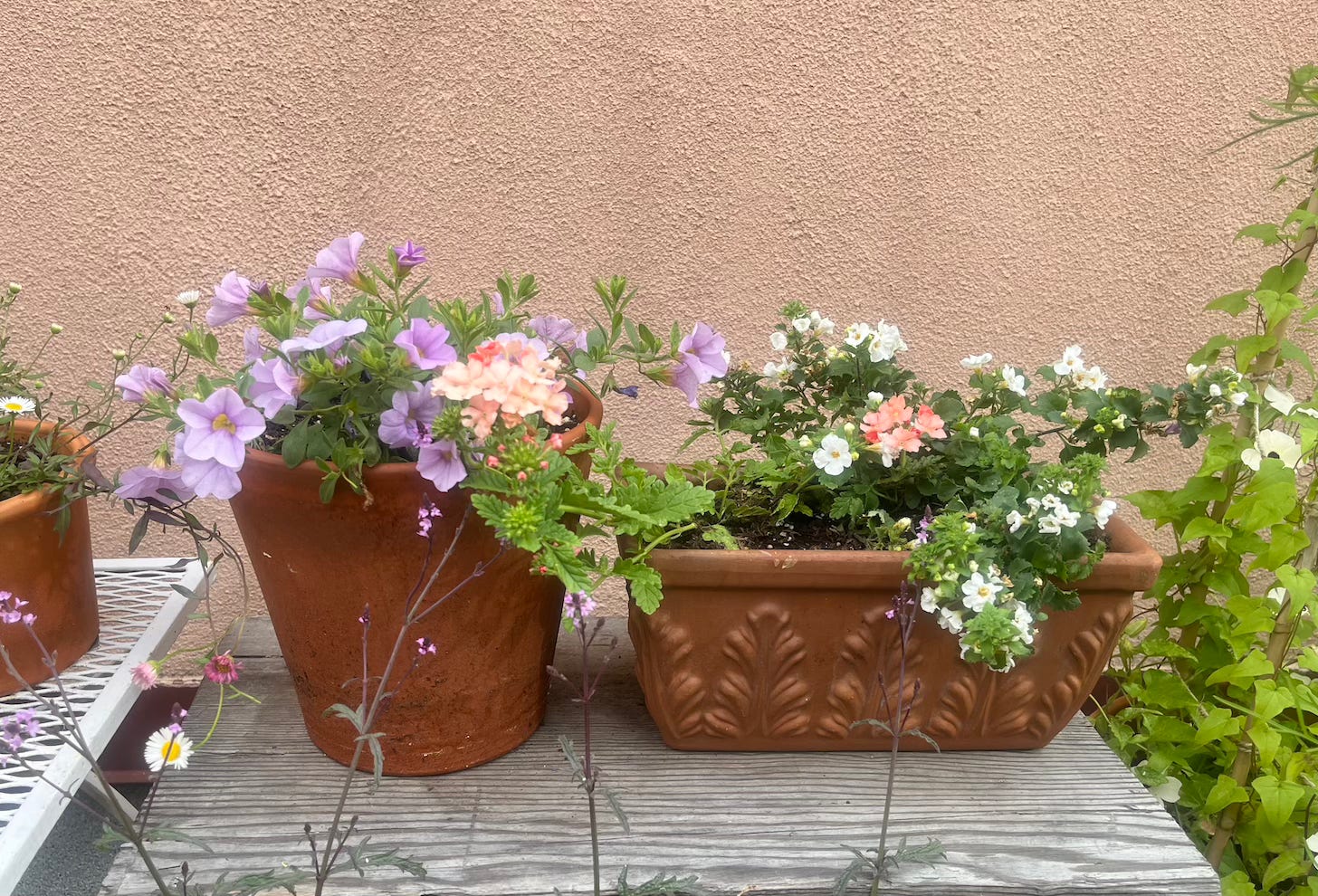Well, the pansy party is slowly coming to an end. We’ve finally had our first hot week this year, and the violas and pansies have shot up tall and are flickering out. I’ve put most of them onto the shady side of the terrace, where they’ll hopefully survive the summer and make a reappearance in the fall. I’ve repotted some of them, too; no need to waste my good pots on some faded-out violas when I can fill them with something that will look bright and happy all summer. But what?
If you read my post about being a wannabe flower farmer it should come as no surprise that I’m a flower snob. I’ve already written about how I was lured into growing flowers by following flower farmers on Instagram, and how at first I only wanted to grow cut flowers. And interesting varieties of cut flowers, too—the harder to find, the better. I blame Floret! Not really, but I’d be lying if I said that the thrill of the seed variety hunt wasn’t a big part of the fun of growing flowers.
In Portland I mainly focused on growing cut flowers, though we did have a few pots of flowers on the deck. I think that we picked out some perennials at Portland Nursery—it was far less interesting to me than the flowers I was growing from seed, though, and I can’t even remember what we chose. It wasn’t until after Portland that I became interested in growing flowers in pots. While living in Asheville for a month I got hooked on HeeYoung’s garden channel on Youtube. She gardens in South Korea and has a proper yard and everything, yet she’d still get just as excited about pot combinations as she would about the David Austin Roses and lilacs and cosmos growing in her yard.
Then Sarah Raven’s A Year Full of Pots came out, and I was sold. I still fill up all of my larger containers and grow bags with cut flowers, of course, but I have lots of small pots that are perfect for smaller annuals and all the sorts of bedding-type plants I’d always scoffed at before. And it turns out that going to the Union Square Greenmarket or to Lowe’s and picking out a few small plants to pair together is fun! Who would have guessed.
There’s an art to putting together plant combinations, and honestly it’s an art that I’m still trying to learn. I can’t tell you how many times I’ve held together a couple of plants at the Greenmarket that looked good at the time, only to take them home and plant them and figure out that they’re all wrong for each other: incompatible sizes, different watering needs, weird-when-combined shapes. My window boxes are especially disastrous this year, which is why I'm not including photos of them, but you can take my word for it. So bad.
Sarah Raven’s book, fortunately, is a sort of bible for pot combinations. Color combinations, too, though I find that part less tricky than figuring out which plants can live together in harmony without fighting too much or trying to outshine each other.
Growing flowers from seed is fun, but there’s a lot to be said for the instant gratification of going to the market and buying little plants already in bloom. Last year I mainly bought perennials, for the very boring reasons of practicality and cost. At Fantastic Gardens (my very favorite stand at the Greenmarket—if you live here please go!) an annual geranium, say, will cost only a dollar or two less than a perennial agastache or salvia or clematis. So I’d buy the perennials, of course. But the downside to a perennial is that it usually doesn’t bloom for as long a period of time as an annual. Yes, my Salvia Bumblesky is beautiful, but the flowers come in random flushes. Right now I have it planted in a window box, but would that window box be pretty for a longer period of time if it were planted with an angelonia instead? Probably.
The other great benefit of growing annuals for us container gardeners is that we don’t have to worry about overwintering them. I bought some perennials last year that didn’t even survive the winter; the cold didn’t do them in, but the rain sure did. Perennials are great and all, but isn’t it kind of nice, at the end of the growing season, to be able to rip out a plant and toss it on the compost heap? (and in case you’re wondering, no we don’t currently compost here in Brooklyn, but, yes, we’re technically supposed to? And, yes, I’m confused about the whole situation . . . So when I say compost heap I mean garbage room at my apartment complex. For now at least). :(

Favorite Varieties
Nemesia: I started growing this last year after reading it about it in A Year Full of Pots; its flowers are shaped like tiny snapdragon blooms, so I guess it seemed like less of a leap for me to grow them? Anyhow they bloomed all summer and well into the cold days of fall.
Violas: I’ve been growing them for a few years, and now I can’t imagine not growing them, but of course you already know that.
Million Bells: Otherwise known as calibrachoa. HeeYoung grows this one a lot (I think she calls it Millennium Bells?) and I do like the variety of colors it comes in. I like that the flowers are on the smaller side, too; definitely smaller and daintier than a petunia.
Bacopa: So I did grow some bacopa from seed—blutopia, I think—but I also picked up a few white bacopas at the Greenmarket this year. It’s actually one of the few plants that’s looking good right now in the window boxes—I put in just one plant, but it’s practically taking over. And it even looks good in flower arrangements, so that’s always a plus.
Verbena: Last year I grew ‘Polaris’ and loved it. This year I planted an ‘Estrella Peach’ in a pot along with a white bacopa. And this peach color! It’s so good.
Angelonia: This one never seems super exciting to me at the market, but it’s so good for filling out space in a pot. Last year it was one of the hardest workers in the window boxes—it just kept growing and growing, even after everything else slowed down.
Lobelia: I love the shape of lobelia: the length of the stems and the tiny little floating flowers. What I’m not crazy about are the colors it comes in. All of the ones I have are a not-great-looking dark blue, and I’ve had a hard time finding anything that’s not dark blue or Barbie pink.
Geraniums: I’ve grown scented geraniums for a few years and I do love a perennial geranium, but I’m slowly warming up to some of the dainty-flowered annual varieties.
Vinca: The leaves are a little too dark and glossy for my taste, and they can look on the tropical side, which, again, is not to my taste. But I did like the pale pink variety I grew last year, if only for adding interesting to a boring space. The flowers themselves are very flat and graphic-looking and somehow pleasing to the eye.
Petunias: This is one I thought I would never grow. The flowers can look a little grotesque to me—I know! I can’t explain it; just the texture of them, especially as they fade—and the colors can be harsh. But I saw a supertunia variety at the hardware store and I actually liked the color (I think it’s Vista Silverberry?) and thought I’d give them a try.
Now, please remember that I call myself a ‘recovering plant snob.’ Are there varieties I still won’t grow? Of course. I really, really don’t like begonias. And I do feel that I’m in good company, considering that even Monty Don calls them “repulsive.” I do still hate a lot of geraniums, including the two plants that I bought for my poorly planned hanging planters. Anything tropical-looking? Not for me. And don’t even get me started on hostas, but I think that prejudice is a hangover from my very first job, working at a specialty hosta nursery in Illinois. Don’t get me wrong—I loved the job! I just didn’t love the plants themselves, and never really got the appeal or understood how people could be so obsessed. I think there was even a hosta club people could join? But, again, I’m in recovery, so who even knows how I’ll feel about them in a year?










Wonderful post as always!! I think I'm definitely a plant snob and Ive had a problem with petunias too. But this year I saw some good ones! Maybe I'll recover too? 😁
Bahaha, I don't really get hostas either but I did have one with incredible smelling flowers. It's dead now.
I like petunias in nice colors and the heirloom ones smell like spearmint and bubblegum.
I heard from Brenna Estrada that you can perennialize some pansies as well as take cuttings! So, who knows, there are ways to keep the pansy party going.